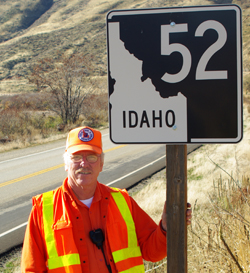
| CONNECTIONS |
IDAHO
ITD
HOME
511 TRAVEL SERVICES
IDAHO
DMV
ITD
NEWS
HIGHWAY
SAFETY
IDAHO STATE POLICE
STATE OF IDAHO
NIATT
NATIONAL
AASHTO
AAMVA
AAA of IDAHO
FEDERAL HIGHWAYS
FEDERAL AVIATION
IDAHO STATE POLICE
NHTSA
NTSB
TRB
U.S. DOT
TRANSPORTER
Archives
Milestones
Comments
Idaho
Transportation
Department
Office of Communications
P.O. Box 7129
Boise, ID 83707
208.334.8005
Fax: 208.334.8563

Idaho 52 almost a second home for Dan Davis;
rural highway undergoes many changes past 24 years
 The next time you travel one of Idaho’s many scenic back roads, take a moment to reflect on the sound of gravel beneath your tires. Oh sure, the mountains loom on all sides, and the lakes and rivers beckon, but the dark patchwork and freshly painted lines on the road are signs that ITD’s engineers and construction workers care about your safety. They’re hard at work year-round to ensure your trips are as trouble-free as possible.
The next time you travel one of Idaho’s many scenic back roads, take a moment to reflect on the sound of gravel beneath your tires. Oh sure, the mountains loom on all sides, and the lakes and rivers beckon, but the dark patchwork and freshly painted lines on the road are signs that ITD’s engineers and construction workers care about your safety. They’re hard at work year-round to ensure your trips are as trouble-free as possible.
Danny Davis is among the cadre of ITD workers who has dedicated much of his life to the effort. For 28 years, he has traversed Idaho’s Southwest region, repairing and replacing deteriorating pavement as a principal maintenance worker and Banks foreman. For 24 of those years, Idaho 52 has been at the center of his work.
“Idaho 52 has evolved over time,” Davis explains, shaking his head with amazement. Davis is the foreman over three sheds – Cascade, Banks and Emmett. He estimates that he supervises eight workers in the summer and about 12 in the winter. “That road doesn’t even hold a resemblance to what it looked like a quarter of a century ago.”
Indeed, the two-way corridor that runs from Idaho 55 at Horseshoe Bend west alongside the Payette River, past Black Canyon Dam, then south into Emmett, has grown from an old, agricultural dirt path to an important paved passage for a handful of growing rural communities.
Browsing through a stack of crumbling biennial reports that chronicle state road projects dating back to 1914, an appreciation grows for the work Davis and all of those around him, and before him, such as Emmett lead worker and supervisor Dennis Moffat, have done, along with Eric Copeland, the lead worker when Moffat retired and now foreman of the New Plymouth shed. A map from 1926 shows the stretch as a dirt road. The first report of surface improvement is recorded in the 1930 book.
 A 1934 report states, “About 10 miles above Black Canyon Dam toward Montour have been widened and surfaced, and now form a very serviceable although circuitous highway. The balance of the route into Horse Shoe Bend is entirely unimproved.” Paving the remainder of the corridor came by the time the 1942 biennial report was published.
A 1934 report states, “About 10 miles above Black Canyon Dam toward Montour have been widened and surfaced, and now form a very serviceable although circuitous highway. The balance of the route into Horse Shoe Bend is entirely unimproved.” Paving the remainder of the corridor came by the time the 1942 biennial report was published.
“When I started on the road in the mid-80s, the lane width was 22 feet. It’s now 25 feet in width,” Davis says.
Much of the road was framed with either sheer rock cliffs or severe drop-offs. Seven miles of Idaho 52 between Emmett and Horseshoe Bend are bordered by water on both sides. “We’ve hauled thousands of tons of gravel to build shoulders and fill in all the drop-offs,” he says proudly. “We’ve saved a lot of lives by doing that.”
When a crash results in death, ITD crews don’t sleep well, Davis says. They wonder what they could have done, or should be doing to prevent the crashes from happening.
“We take it very personally,” he says.
 Still, maintenance efforts are limited by manpower and funding. “We do what we can, and I think we get a lot done with what we have, but people have to remember that some of these old roads were not built for high-speed vehicles, and they need to take responsibility for their own safety.”
Still, maintenance efforts are limited by manpower and funding. “We do what we can, and I think we get a lot done with what we have, but people have to remember that some of these old roads were not built for high-speed vehicles, and they need to take responsibility for their own safety.”
Davis right now oversees three crews building an extended shoulder near milepost 38 (where five teenagers drowned in a traffic off the road accident in late February, 2007.) The work involves building a rock shelf at the bottom of a retention pond, then piling on a series of “burrito wraps” made of dirt wrapped in filter fabric. When completed, the shoulder will be 20-feet wide and extend the full length of the pond next to the road. The rock and dirt is being hauled in from an excavation site down the road.
Davis cautions that no amount of improvement to winding, narrow, mountainous roads such as Idaho 52 will substitute for good common sense. He urges motorists to slow down, buckle up and call 511 ahead of time for road conditions, especially during the winter months when visibility may be limited and the roads icy.
Published 11-21-8